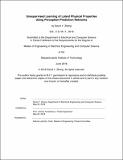Unsupervised learning of latent physical properties using perception-prediction networks
Author(s)
Zheng, David Y., M. Eng. Massachusetts Institute of Technology
DownloadFull printable version (2.676Mb)
Other Contributors
Massachusetts Institute of Technology. Department of Electrical Engineering and Computer Science.
Advisor
Joshua Tenenbaum.
Terms of use
Metadata
Show full item recordAbstract
We propose a framework for the completely unsupervised learning of latent object properties from their interactions: the perception-prediction network (PPN). Consisting of a perception module that extracts representations of latent object properties and a prediction module that uses those extracted properties to simulate system dynamics, the PPN can be trained in an end-to-end fashion purely from samples of object dynamics. We find that the representations of latent object properties learned by PPNs not only are sufficient to accurately simulate the dynamics of systems comprised of previously unseen objects, but also can be translated directly into human-interpretable properties (e.g. mass, coefficient of restitution) in an entirely unsupervised manner. Crucially, PPNs also generalize to novel scenarios: their gradient-based training can be applied to many dynamical systems and their graph-based structure functions over systems comprised of different numbers of objects. Our results demonstrate the efficacy of graph-based neural architectures in object-centric inference and prediction tasks, and our model has the potential to discover relevant object properties in systems that are not yet well understood.
Description
Thesis: M. Eng., Massachusetts Institute of Technology, Department of Electrical Engineering and Computer Science, 2018. This electronic version was submitted by the student author. The certified thesis is available in the Institute Archives and Special Collections. Cataloged from student-submitted PDF version of thesis. Includes bibliographical references (pages 22-24).
Date issued
2018Department
Massachusetts Institute of Technology. Department of Electrical Engineering and Computer SciencePublisher
Massachusetts Institute of Technology
Keywords
Electrical Engineering and Computer Science.